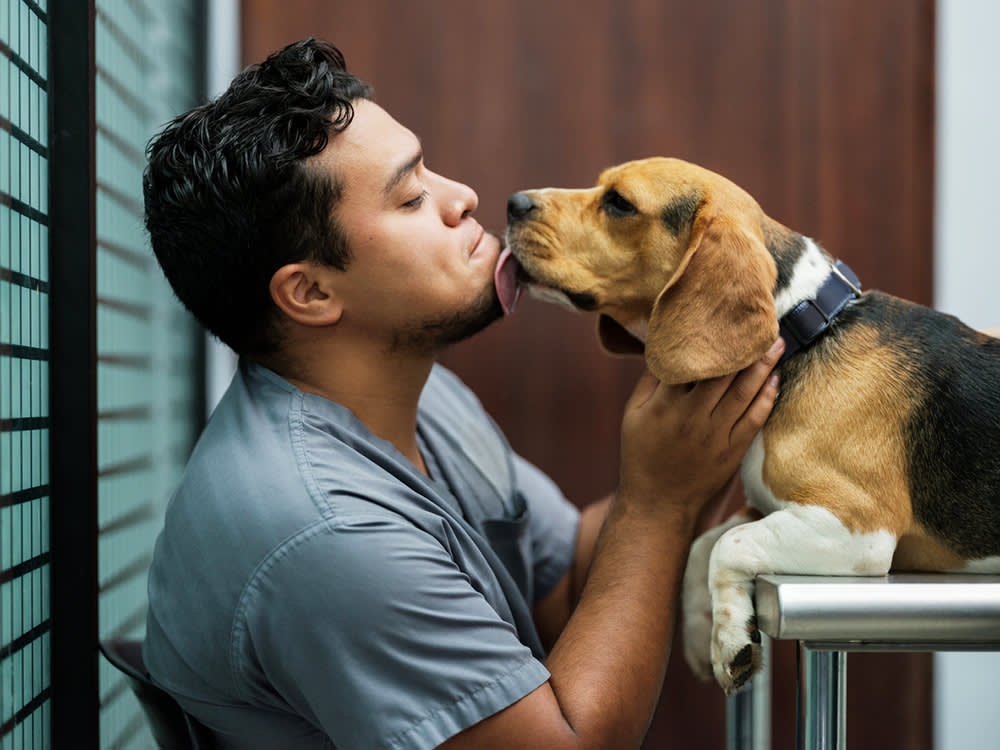What is Sterile Meningitis in Dogs?
Meningitis can be a scary word to hear, but it’s not as bad as you might think – a vet explains the signs to look out for and the treatments available

share article
During my time practicing as a veterinary neurologist, nothing seems to instil fear into the hearts of dog parents more than the word ‘meningitis’. Our dogs are our best friends, so it’s natural to be concerned about their health. However, meningitis in dogs is usually not the same menace we have grown wary of in humans, and although it is a disease that should be taken seriously, it has a better outlook than one may think.
What is sterile meningitis (SRMA)?
SRMA stands for Steroid Responsive Meningitis-Arteritis, and it refers to inflammation of the lining of the central nervous system (meningitis) and inflammation of blood vessels (arteritis). This inflammation is sterile, meaning there is no infectious agent driving the inflammation. It is thought to be caused by an inappropriate reaction of the dogs’ own immune system against the lining of the nervous system and blood vessels. Dogs can get bacterial and viral meningitis (which is the same form as humans) but it is extremely rare, with the vast majority of meningitis in dogs being the sterile form.
Which dogs are at risk?
SRMA predominantly affects young dogs. It can affect any breed, but certain breeds such as the Boxer, Beagle, Bernese Mountain Dog, Whippet, Golden Retrievers and Wirehaired Pointing Griffons have been shown to be predisposed (it is presumed this is for genetic reasons but research is yet to identify a specific gene). When the disease was first discovered in the ’90s, it was initially called ‘Beagle Pain Syndrome’, as Beagles seemed to be so overrepresented. Unfortunately, as SRMA is an immune response, there is nothing that can be done to prevent it.
Signs and symptoms
As with many illnesses in dogs, early detection can have a positive impact on the outcome of the dog’s health. Here are the signs and symptoms to look out for.
Neck pain: this is one of the most common symptoms and pet parents will often complain that their pup seems stiff and reluctant to move their head. They may also report difficulty reaching down to get to their food or water bowl.
Fever: your dog may feel warmer and become lethargic and withdrawn. Fever or elevated body temperature is a very common symptom of SRMA. However, this fever can come and go, so may not always be present, particularly if your vet has prescribed something to bring down a fever.
Lethargy and reluctance to move: your pup may also appear weak, fatigued or uninterested in usual activities.
Spontaneous yelping or crying out: some pet parents report that their dog is yelping in apparent pain with no obvious cause.
Reduced appetite: dogs will often go off their food due to pain, fever or not being able to reach down to the bowl.
What to do if you suspect your dog may have SRMA
If a combination of these symptoms are present, it’s crucial to seek veterinary care ASAP. Your vet will take a careful history and examine your pup – they may recommend various tests, including blood tests, analysis of the fluid that surrounds the brain and spinal cord, and imaging like MRI or CT scans to confirm the diagnosis and rule out other suspicions. Some of these tests are quite specialised, so referral to a specialist veterinary neurologist may be required. Your vet may also test for a marker of inflammation in the blood called CRP. CRP is elevated in lots of different diseases that cause inflammation, but it is useful when monitoring response to treatment in dogs with SRMA.
How is SRMA treated?
The main treatment is with corticosteroids, which are anti-inflammatory steroids. Most dogs respond very well to treatment with high doses of Prednisolone (a type of steroid). The steroid acts to suppress the immune response and reduce the inflammation. Your veterinarian will determine the appropriate dosage and duration of treatment tailored to your dog’s specific needs; however it is important to note that high doses over a few months is the norm. Some dogs may require additional pain relief and some require other drugs alongside steroids to help suppress the immune system further. Gradual tapering of the steroid dose under veterinary guidance is suggested to help prevent relapses and minimise potential side effects associated with prolonged steroid use, which can include panting, drinking more, urinating more, increased appetite and a pot-bellied appearance. Regular follow-up visits to the vet will help monitor your dog’s progress and allow the vet to adjust the treatment plan as necessary.
Things you can do to help
When your pet is feeling low, extra TLC can go a long way. Some things you can do include taking care to raise the food and water bowls to help with neck pain, and adding some cooked chicken to their food, which may encourage dogs with a low appetite to eat more. If your dog usually wears a collar and lead for walks, try switching to a harness that avoids the neck while it’s sore. Also try and avoid startling your dog with sudden movements or loud noises, which may cause them to move suddenly and trigger a painful response.
Make sure all medication is given as advised; steroids can make dogs hungrier and thirstier, too, and therefore they may need the toilet more often. While it’s important not to feed them more (no matter how much they beg), adding fibre to their diet can make them feel fuller and less hungry while on their course of steroids. Always make sure they have access to water and offer them the opportunity to go out to the toilet more frequently to avoid accidents.
SRMA can be a painful and worrying condition, particularly causing pain in the neck and spine, however prompt diagnosis and treatment with steroids is often very effective at managing the symptoms. Relapses of SRMA can occur throughout your dog’s life but careful monitoring with regular check-ups at the vet can help catch any relapses early and stop them in their tracks.

Dr Georgina Harris, MRCVS, DipECVN
Georgina Harris is a veterinary neurologist whose career started at the Royal Veterinary College. She then went on to specialise in neurology and neurosurgery at Cambridge University. Georgina enjoys all aspects of neurology. Outside of the clinic, she can be found travelling round the UK in her campervan with her trusty canine companion Olive, the Finish Spitz.


